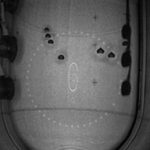The headline story in the April 15 issue of Fermilab Today featured the observation by the CDMS experiment of three candidate events that could have been produced by dark matter. That result, combined with several other possible signals, points to a dark matter candidate that is much lighter than expected. While no one is claiming… More »
Hugh Lippincott
This month is an important one for the COUPP-60 detector. In the race to detect dark matter, experimentalists want to go deeper and get bigger, and with COUPP-60, the COUPP collaboration is hoping to do just that. For the past two years, the COUPP-4 detector containing about 4 kg of target has been running 6800… More »
The COUPP Collaboration uses bubble chambers to search for dark matter. The experiment works because the fluid in the detector is in a “superheated” state – the fluid wants to boil but needs something to give it the extra heat to make a bubble. Particle interactions with neutrons, alphas or potentially dark matter can give… More »
As described previously in this space, the COUPP Collaboration uses bubble chambers to search for dark matter particles. We just finished a run of our 4 kg bubble chamber in the deep underground site of SNOLAB in Northern Ontario. This run was successful in many ways, particularly in demonstrating the reach of the acoustic rejection… More »
The COUPP program puts a new twist on an old technology, bubble chambers, to search for dark matter. Recently, COUPP has been able to discriminate between potential dark matter signals and one of the most troublesome backgrounds, alpha decays, by listening to the sound of bubble formation – alphas are louder. Results showing this effect… More »










